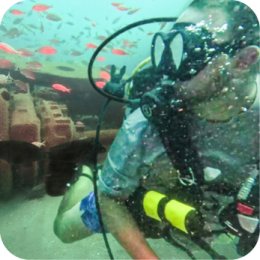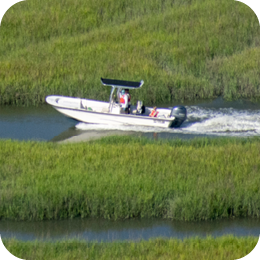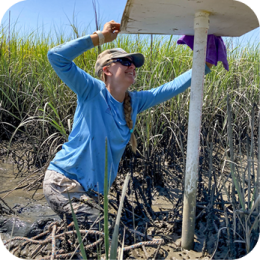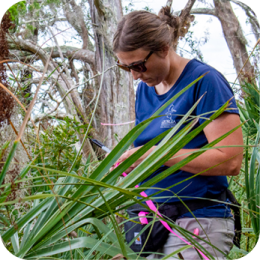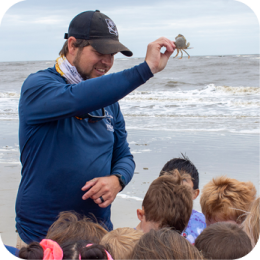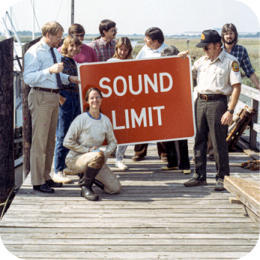About the Georgia Healthy Beaches Program
Welcome to the Georgia Healthy Beaches page. The Beach Water Quality Monitoring and Notification program is a cooperative effort of the Georgia Department of Natural Resources' Coastal Resources Division and the Georgia Department of Health's Coastal Health District. The program is funded by a grant from the U.S. Environmental Protection Agency.
The water at Georgia's coastal swimming beaches is tested regularly for the presence of potentially harmful bacteria.
Below is a quick video showcasing the work of the beach program and several useful links to help keep visitors safe while enjoying Georgia's approximately 105 miles of sandy beaches.
Beach Swimming Advisories
When a beach yields a water sample that is found to contain a bacteria level greater than 70 colony forming units per 100 mL of water (cfu/100mL), the beach is placed under advisory. The map below shows current beach water quality sampling locations, most recent bacteria levels, and advisories. Beaches that are placed under advisory are retested the same week.
Georgia Beach Map App
This app is the perfect way to plan your beach trip around Tybee, St. Simons and Jekyll islands. The app includes parking, seasonal lifeguard locations, beach access points, beach water-testing segments, the latest bacteria counts, and applicable beach rules. If your mobile device allows your location to be shared, it will display in the map, making it easy to see if the segment you're visiting is under advisement.
Planning a Safe Day at the Beach
There are 56 Beach Advisory signs posted along the Georgia coast at popular access points on Tybee, St. Simons, and Jekyll Islands. These signs show the current advisory status of a beach based on the result of the most recent water sample. Our data has shown that elevated bacteria levels are frequently associated with specific weather events, especially heavy rains and strong winds. Significant levels of rainfall increases runoff from surrounding uplands and may contribute to elevated bacteria levels in adjacent waters. Similarly, high winds along with heavy surf conditions will often resuspend sediment loads in the water column and may increase bacteria levels.
In summary, beachgoers and especially swimmers should always consider the past 24-48 hour weather conditions from the local area along with the posted advisory status when making plans on enjoying any of Georgia’s beautiful beaches.
Beach Monitoring FAQ
- Why are beaches tested and what are they tested for?
The water is tested as part of the U.S. Environmental Protection Agency's beach monitoring program, which includes all of Georgia's beaches. Water samples are taken along beaches and tested for the bacteria enterococcus (pronounced en-ter-o-coc-cus), which is found in the guts of warm-blooded animals, including humans, birds, raccoons, deer, dolphins, and other wildlife.
- How does enterococcus get into waterways?
It is difficult to pinpoint where bacterias come from, but some sometimes they can contaminate water when animal scat or feces is carried downstream by rain. Bacterias can also come from accidental discharges, boat waste, and a variety of other sources. It is important to pick up pet waste and dispose of it property to keep beaches from becoming contaminated.
- What does it mean when a beach is under advisory?
An advisory means the level of bacteria found in the water is above the U.S. Environmental Protection Agency's recommended standards. When the level of bacteria is higher than acceptable levels, there is an increased risk of illness to swimmers. When a beach is under advisory, swimming or wading in that area is not recommended. However, an advisory does not mean the beach is closed. Our Beach Water Quality program never closes beaches -- it only advises that swimming may be more risky.
- Will I get sick if I go into water that is under advisory?
There is no way to say for sure whether or not you will get sick if you go into water that is under advisory but you will be at an increased risk of illness. Risk of illness comes from contacting beach water in several ways including ingesting water while swimming, getting water in the nose, eyes, and ears or getting water in an open wound. Some examples of possible illness include possible stomach upset, ear infection, sore throat, or wound infection.
- What do I do if I have been swimming in water that was under advisory but I didn’t realize it?
There is no way to say for sure whether or not you will get sick if you were swimming or wading in water that was under advisory. The best thing to do is to be aware of any changes in your health. If you start to experience stomach upset, ear infection, sore throat, or wound infection, after you have been in contact with water that was under advisory, contact a healthcare provider.
- Do beaches close when they are under advisory?
No, the beach is not closed. An advisory simply means that increased levels of bacteria were found in the water, not on the beach, which is why public health suggests no swimming or wading in the water (risk of illness comes from contact with the water).
- Does the advisory cover the entire island?
No. An advisory only covers a certain area. Even if part of the beach is under advisory there are plenty of other beach access points to areas that aren’t under advisory.
- How do you know the bacteria are only in one certain area of the water?
Beaches have been divided up into zones. Water samples are taken from the center of each zone and if bacteria levels are found to be higher in a certain zone then an advisory is issued for that area. Because it's not possible to determine exactly where the bacteria levels switch from "OK" to "elevated," the advisory is issued for a fairly large area. If water samples from more than one zone indicate higher levels of bacteria then multiple advisories will be issued but again, only for the areas where bacteria is higher.
- How long do areas stay under advisory?
When an advisory is issued, another sample of the water in the area under advisory is taken within a few days and retested. An area will stay under advisory until the test shows that bacteria in the water have decreased to an acceptable level as determined by the U.S. Environmental
Protection Agency.- How often is beach water tested?
Water at the beaches on Jekyll, St. Simons, and Tybee Islands is tested once a week, during the swimmer season and bimonthly during the winter. Beaches that are under permanent advisory are tested once a quarter (four times a year).
- What does it mean if a beach is under a permanent advisory?
A permanent advisory means that there are continually elevated bacteria levels indicating a potential human health risk and therefore swimming or wading is advised against.
- Can I eat fish I’ve caught from a beach that’s under advisory?
Yes, fish and other seafood caught in area(s) should be thoroughly washed with fresh water and thoroughly cooked before eating as should fish or seafood caught from any waters.
- What is the most current status of Georgia's beaches?
Check the map above. The green dot symbol means that the bacteria levels are acceptable at that beach. The yellow dot symbol means that bacteria levels at that beach are elevated and swimming at that beach is not advised.
Contact us
If you have additional questions about the Georgia Healthy Beaches program, contact program manager Ed Zmarzly at edward.zmarzly@dnr.ga.gov or (912) 264-7218.



